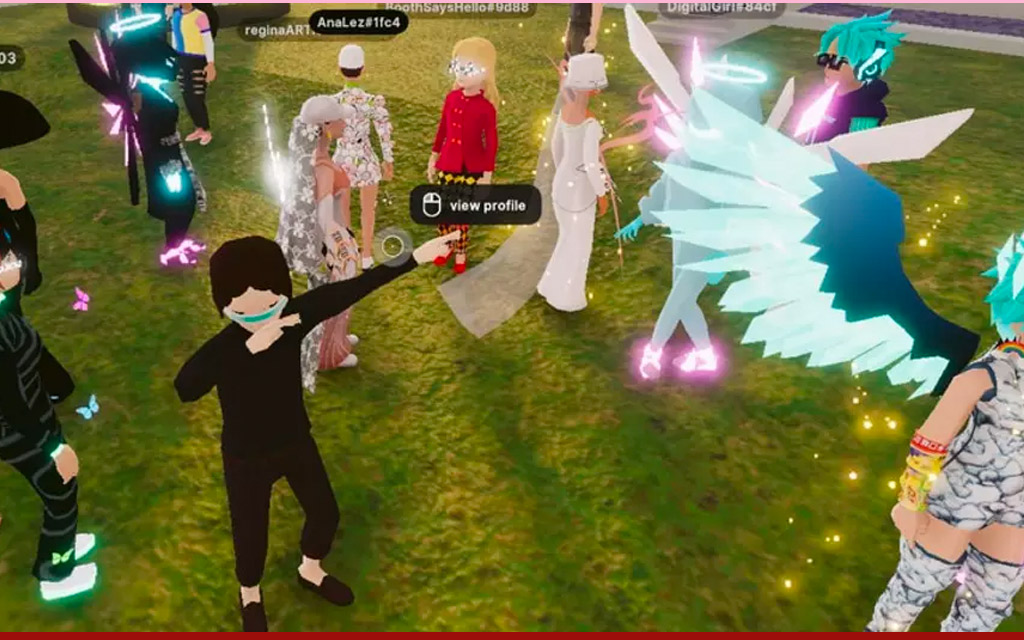Fashion shows are too often about VIP red carpets, emaciated models and sartorial creations that don’t function particularly well in the real world. So it was kind of liberating to attend Metaverse Fashion Week (MVFW) a celebration of fashion with over 70 participating brands, held in Decentraland’s Fashion District from March 24 -27. The participating companies included some that arelegendary in the physical world, some that are just emerging, and some that are digitally native. They bought, rented and partnered to create virtual spaces that added up to a new kind of fashion experience.
The tech, as so often in today’s metaverse platforms, was sometimes messy and slow, and navigating the landscape was super-awkward. But despite technical gaffs it was easy to feel we were a part of something important. The inclusivity of it all, at least for now, was palpable. Unlike most real-world fashion events, anyone could attend; no need to know somebody who knew somebody. All body sizes and colors were welcome (even pink, blue and green). And you could wear whatever you wanted. (Of course, everyone knew you were a newbie if you dressed in what was freely available on Decentraland.
Knowing participants spent some hefty coin to dress their digital avatars. Wings, it seems, are among the most coveted virtual fashion accessories. At parties like the “Metaverse Cocktail Hour for Fashionistxs,” hosted by Cash Labs, it was abundantly clear who had MANA (the currency of Decentraland) to spend on fancier gear. The spotlight was on those who sported massive sets of wings, bear costumes, or swarms of digital butterflies.
Navigating Metaverse Fashion Week was a lot like playing a 1990’s video game. I moved around my avatar with those keyboard keys that every gamer holds near and dear–W, A, S, D–which allowed me to move back, forward, left or right. Other keystrokes let you jump or map your whereabouts.
I spent a few hours bumping into walls, overhearing bizarre conversations, walking through other avatars, trying on digital outfits, attending runway shows, attending after-parties and meandering through storefronts. Mostly I got lost. A lot. Apologies to my fellow fashionista avatars for looking like a cross between a drunk and a whirling dervish.
The experiences ranged from silly to sublime. One of the most talked about? Tommy Hilfiger invited consumers to teleport their avatars to its virtual store to shop any of its floating, limited 3D renditions of its spring collection. They were NFTs that you could redeem for physical goods later. The online store is supported through a partnership with Boson Protocol, which provides a “universal commerce settlement layer for Web3.” It was a great example of how the metaverse may spur real-world retail sales.
Estée Lauder gave away 10,000 NFTs validating proof of attendance. POAP (Proof of Attendance Protocol) is like getting a door prize just for showing up. The prize was that your avatar received a sparkly glow (mimicking the effect of the company’s real-life products on real-life skin.) Selfridges created a metaverse department store that looked like a giant avatar itself (see image) where you could experience both Paco Rabanne’s fashion and Victor Vasarely’s art. Auroborous capped off the weekend with a prepared DJ set from the musician Grimes. For a blow-by-blow of the events, follow BryteHall.

All told, what I witnessed felt both inscrutable and important at once–a meeting of the silly and the sublime, the confounding and the beautiful. It offered a glimpse at the future of a world where distinctions between reality and digital will blur.
If You Wish It They Will Come
The metaverse and NFTs have all the makings of a modern-day Gold Rush. According to Vogue Business, 108,000 people attended the show. That not a huge number compared to the 12 million who showed up for the Twenty One Pilots concert in Roblox, but it was a solid start. Bloomberg estimates the metaverse will be worth $800 billion by 2024. Salaries for workers who create the metaverse are commanding upwards of $400,000. Business Insider says Roblox is paying $430,000 for senior metaverse experts. “Ad agencies are reporting conversion rates of about 70%, on average, compared to 30% on plain ole online channels that the brands would use,” said Emperia co-founder and CEO Olga Dogadkina. Her company creates immersive digital experiences for fashion, retail and art.
The audience has the appetite. Around 75% of Gen Z consumers have bought a digital item within a video game and 60% believe companies should sell merchandise on metaverse platforms, according to a January survey of 1,001 U.S. consumers by e-commerce platform Obsess. The company has designed virtual stores for Coach, Ralph Lauren, and Christian Dior. Sam Hamilton, Decentraland Foundation’s creative director, reports there were $1 million in sales of avatar wearables there last year.
Technical limitations still present obstacles for total immersion. For example, each Decentraland server has a maximum attendee limit, so you may find yourselves suddenly separated from your friends. And there’s a high cost for brands to do it right, since engagement and interactivity are key. But there’s definitely an audience keen to spend real dollars on virtual experiences.
Remember Professor Harry Hill in the Music Man? He waltzes into town, sells the entire town on buying uniforms and band instruments and then encourages the “think method”. If the band thinks about the music long and hard enough, they will magically play. We’re at that point in the metaverse. Many are thinking “metaverse”, and it appears to be working.

Best part of trying on my dress in Decentraland was that I didn’t have to undress first.
Source: https://techonomy.com/wings-are-the-newest-accessory-at-metaverse-fashion-week/




